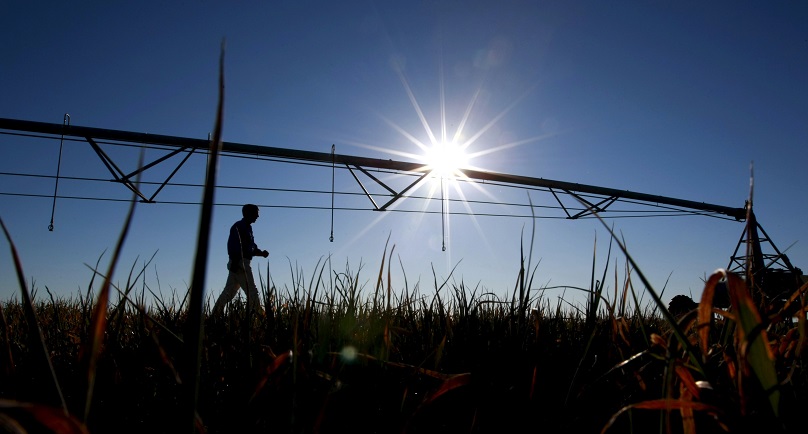Image: A farmer walks past a mobile irrigation boom on a dying oat crop on his farm in the heart of Australia’s Murray-Darling river basin outside Moulamein, west of Canberra, in this August 24, 2007 file photo. REUTERS/Tim Wimborne/Files
![]()
By Colin Packham
SYDNEY (Reuters) – A pioneering Australian scheme to improve the management of water in the world’s driest inhabited continent is facing its first real test as an intensifying El Nino threatens crops and builds tensions between farmers and environmentalists.
The three-year old management plan for the Murray-Darling basin, an area twice the size of Spain and home to 40 percent of Australia’s agricultural output, has been lauded internationally and suggested as a guide for drought-hit California.
Forged in the wake of a ruinous 14-year drought, the scheme set up a market-based water trading system, improved cooperation across state borders and focused on efficient water usage.
“All of these lessons are appropriate to the United States,” said water policy expert Professor David Feldman of the University of California, Irvine, where the state is suffering from a four-year dry spell that has threatened agriculture and helped fan severe wildfires this summer.
Australia’s Murray-Darling basin encompasses two major river systems in Australia’s southeast, but years of siphoning off water to irrigate crops has devastated waterways, creating dried-out wetlands and acidic soils, toxic algal blooms that threaten animal and human health, and high levels of salinity.
A 2012 water management plan instituted a raft of water-saving measures, and set up a market-based system where farmers who have been allocated water rights under decades-old systems can trade their entitlements.
Under the scheme, the government buys water to keep the river healthy, farmers can buy water to irrigate crops in lean years or during the hot summer season, and investors are also welcome.
DROUGHT PRESSURE
But changes to the Australian plan amid a resurgent El Nino weather pattern have worried environmentalists who say its reputation and credibility are now at risk.
The plan initially met little resistance in rural areas, but dry weather this year has depleted some dams that store river water, forcing farmers to accept big cuts in their water entitlements.
The loss is particularly hard for summer crops that rely heavily on irrigation like cotton, rice and sorghum. Australia is the world’s fourth-largest exporter of cotton.
Cotton accounts for about A$2 billion ($1.4 billion) in export earnings, or about 7 percent of total crop earnings, and production is forecast to fall nearly 10 percent in the year to end-June 2016 from last year’s five-year low.
While the dry weather is hastening a shift from water-intensive crops like cotton and rice, it has also sparked calls for changes to the management plan as farmers say too much water is being used for the environment.
While farmers can buy water on market, prices have jumped sharply to more than A$200 ($145) a megalitre in some regions – well in excess of viable limits for many, who argue that having to compete with the government has driven up prices.
CAPS AND OVERSIGHT
Australian lawmakers last week nearly halved the amount of water the government can buy from local farmers, instead giving farmers subsidies to save water that would then be available for sale.
Environmentalists and some academics question the changes, which the Australian Conservation Foundation (ACF) says will cost up to five times the market rate of buying water, while there is also a physical limit on how much can be saved.
This week, the government transferred management of Australia’s water resources from the Department of the Environment to the Department of Agriculture, a move long sought by rural bodies.
“It introduces a remarkable conflict of interest between a minister whose job it is to promote the agricultural industry and now under this arrangement, a minister who will be responsible for securing the health of water resources that are used by that industry,” said ACF campaigner Jonathan La Nauze.
Academics say the scheme has had some success in improving the health of the river system, and will survive in its basic form given the importance of the basin to all water users.
“Any tinkering will be at the edges and not the core,” said Willem Vervoort, associate professor in hydrology and catchment management, the University of Sydney. “If the water quality keeps deteriorating then the irrigators are out of business. In the end, the irrigators have a stake in the environment too.”
The University of California’s Feldman said legal and political differences would make it difficult to implement parts of the Australian system in the United States, where water rights remain linked to property rights.
However, the lessons for California included overcoming the fragmented authority for water management and getting public buy-in on how to best save and use water, he said.
(Reporting by Colin Packham; Editing by Richard Pullin)
Copyright 2015 Thomson Reuters. Click for Restrictions.


